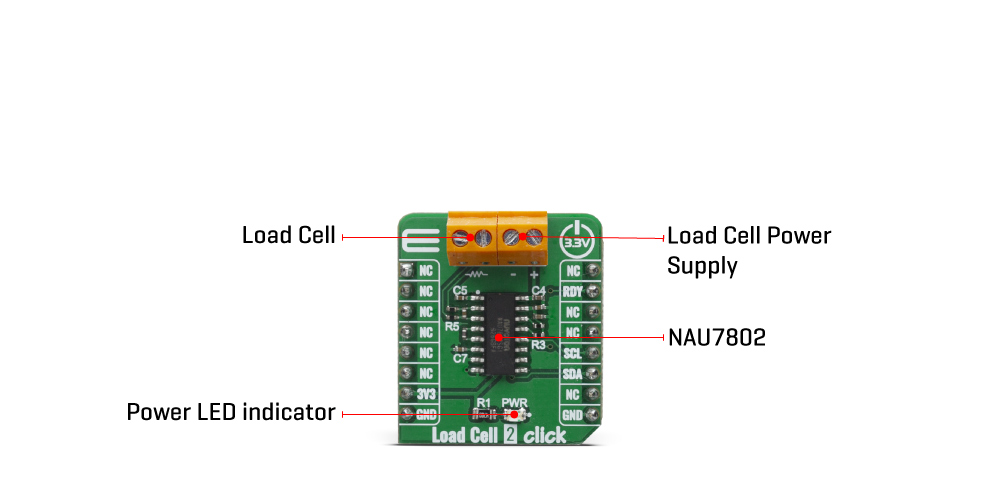






Overview
The Load Cell 2 Click Board™ is a weight measurement click that utilizes a load cell element, in order to precisely measure the weight of an object. The Load Cell 2 Click can be used with the strain gauge type of load cells with external differential reference voltage range from 0.1V to 5V. The strain gauge load cell is typically a circuit made of four strain gauges, connected in the Wheatstone bridge configuration. Very small voltage changes need to be accurately detected and converted into a digital form. The Load Cell 2 Click is based around the NAU7802, which is a 24-bit analog-to-digital converter, operated via a simple I2C command, from Nuvoton. This sensor has many features that make it a perfect solution for small designs. One of these features is certainly its high level of integration that allows a minimal number of external components.
The Load Cell 2 Click Board™ is supported by a mikroSDK compliant library, which includes functions that simplify software development. This Click Board™ comes as a fully tested product, ready to be used on a system equipped with the mikroBUS™ socket.
Downloads
How Does The Load Cell 2 Click Board™ Work?
The Load Cell 2 Click Board™ is based on the NAU7802 is a precision low-power 24-bit analog-to-digital converter (ADC), with an onboard low-noise programmable gain amplifier (PGA), onboard RC or Crystal oscillator, and a precision 24-bit sigma-delta (Σ-Δ) analog to digital converter (ADC). The NAU7802 device is capable of up to 23-bit ENOB (Effective Number Of Bits) performance. This device provides a complete front-end solution for bridge/sensor measurement such as in weigh scales, strain gauges, and many other high resolution, low sample rate applications.

The NAU7802 have many built-in features, which enable high performance applications with very low external parts count. Additionally, both operating current and standby current are very low, and many power management features are included. These enable powering only those elements of the chip that are needed, and also, to operate at greatly reduced power if the full 23-bit ENOB performance is not required.
The Programmable Gain Amplifier (PGA) provides selectable gains from 1 to 128. The A/D conversion is performed with a Sigma-Delta modulator and programmable FIR filter that provides a simultaneous 50Hz and 60Hz notch filter to effectively improve interference immunity. Also, this device provides a standard 2-wire interface compatible with I2C protocol for simple and straightforward connection to and interoperation with a wide range of possible host processors.
Calibration is not required for low accuracy applications, but may be needed in sensitive applications. When calibration is used the system designer has three options (details in NAU7802 datasheet).
The power supply is 3.3V and this allows only 3.3V MCUs to be interfaced with the Click boards™ directly.
SPECIFICATIONS
| Type | Force |
| Applications | NAU7802 provides a complete front-end solution for bridge/sensor measurement such as in weigh scales, strain gauges, and many other high resolution, low sample rate applications. |
| On-board modules | NAU7802 24-Bit Dual-Channel ADC For Bridge Sensors |
| Key Features | NAU7802 is a precision low-power 24-bit analog-to-digital converter (ADC), with an onboard low-noise programmable gain amplifier (PGA), onboard RC or Crystal oscillator, and a precision 24-bit sigma-delta (Σ-Δ) analog to digital converter (ADC) |
| Interface | I2C |
| Compatibility | mikroBUS |
| Click board size | S (28.6 x 25.4 mm) |
| Input Voltage | 3.3V |
PINOUT DIAGRAM
This table shows how the pinout of the Load Cell 2 Click Board™ corresponds to the pinout on the mikroBUS™ socket (the latter shown in the two middle columns).
| Notes | Pin |  |
Pin | Notes | |||
|---|---|---|---|---|---|---|---|
| NC | 1 | AN | PWM | 16 | NC | ||
| NC | 2 | RST | INT | 15 | RDY | Data Ready | |
| NC | 3 | CS | RX | 14 | NC | ||
| NC | 4 | SCK | TX | 13 | NC | ||
| NC | 5 | MISO | SCL | 12 | SCL | I2C Clock | |
| NC | 6 | MOSI | SDA | 11 | SDA | I2C Data | |
| Power Supply | 3.3V | 7 | 3.3V | 5V | 10 | NC | |
| Ground | GND | 8 | GND | GND | 9 | GND | Ground |
ONBOARD SETTINGS AND INDICATORS
| Label | Name | Default | Description |
|---|---|---|---|
| LD1 | PWR | - | Power LED Indicator |
| General Information | |
|---|---|
Part Number (SKU) |
MIKROE-4047
|
Manufacturer |
|
| Physical and Mechanical | |
Weight |
0.018 kg
|
| Other | |
Country of Origin |
|
HS Code Customs Tariff code
|
|
EAN |
8606018717118
|
Warranty |
|
Frequently Asked Questions
Have a Question?
Be the first to ask a question about this.







